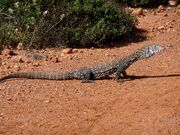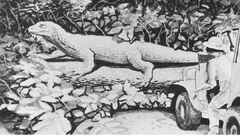| ||||||||||||
The giant goanna is a cryptid reported from Australia, sometimes identified with the mythological mungoon-galli.[1] Australia's largest known lizard is the perentie (Varanus giganteus), and some cryptozoologists suggest that oversized specimens could explain reports of giant monitors, while others controversially identify the cryptid with the giant Pleistocene varanid Megalania (Varanus prisca).[2][3]
Attestations[]
Giant lizards have long been rumoured from parts of eastern Australia, supposedly as early as 1830 in the Watagan Mountains.[3] In 1986, Bernard Heuvelmans referred to sightings of monitors as long as 30 ft (9 m), particularly from the forests of northern Queensland, where they inhabited tropical rivers and lakes, as well as further south, from the mountain scrublands of New South Wales, around the Murray River, and near Lake Alexandrina in Victoria.[4][1]
Sightings[]
Undated[]
Gary Opit investigated a giant lizard sighting made near Brunswick Heights (New South Wales), at the mouth of the Brunswick River. A woman claimed to have seen the animal sprawled across a Fingle Street road, taking up the road's entire 20 ft (6 m) width. The lizard eventually rose up and disappeared into the bush.[5]
1931[]
Fred Blakeley, the brother of Australian politician Arthur Blakeley, claimed to have seen a giant lizard in central Australia, while accompanying a party of prospectors. According to Blakeley, the lizards, which had been seen by settlers and were feared by local Aboriginal inhabitants, grew to 15–18 ft (4.5–5 m). An old prospector named Big Jim claimed to have been attacked by such an animal, which lashed its tail, arced its back, and made a noise like a mixture of a dog's bark and a lion's roar. Blakeley investigated the scene the following day, and discovered claw marks in the sand 6 ft 3 in (1.9 m) apart, indicating a length of 15 ft (4.5 m).[3][6] He believed the animal had been a giant perentie, which he set out to capture in 1940.[7]
1984[]
One of the most detailed giant goanna sightings was made by Peter Sleeman in 1984, in the subtropical rainforest of the Limpwood Nature Reserve. Sleeman told Gary Opit that, hearing movement behind him, he sidetracked into a clearing and saw that he was being followed by an enormous monitor lizard. Based on his view of the head, front limbs, and forequarters, the lizard resembled a lace monitor (Varanus verius), but was far larger; while the lace monitor has a 6 in (15 cm) head, this lizard's head was four times that size, and was held around 3 ft (91 cm) from the ground. It did not notice Sleeman in the clearing, and soon disappeared. Richard Freeman estimates that the lizard would have been 20–26 ft long (6–8 m).[5]
Theories[]

The perentie (Varanus giganteus) is Australia's largest known monitor, growing to at least 8' long.

Some cryptozoologists suggest that a surviving Megalania (Varanus prisca) could explain reports of giant goannas (CC BY 3.0).
Perenties (Varanus giganteus), the largest known lizards in Australia and the fourth-largest in the world, generally grow to 5–7 ft (1.5–2 m), but can be somewhat larger. A 12 ft (3.6 m) perentie skin allegedly observed by naturalists was thought to have been artificially stretched.[8] Stories of such large specimens were considered apocryphal and dubious until the 1930s,[9][8][10][11] leading to perenties in the known size range being termed "giant goannas," and being treated as cryptids. It is widely suggested that even larger specimens could explain reports of giant goannas.[2][12] The 10–15 ft (3–4.5 m) long crocodile monitor of Papua New Guinea is the correct size, and, although it is not known from Australia, Karl Shuker argues that its presence there cannot be ruled out.[3] Jon Downes agrees that a relative of the slender crocodile monitor could explain such reports.[13]
Bernard Heuvelmans suggested in 1986 that reports of giant lizards could refer to a surviving Megalania (Varanus prisca),[1] history's largest known monitor lizard, a theory most famously promoted by Rex Gilroy. The exact size of Megalania in life is unknown, but it may have had a maximum length of 23–26 ft (7–8 m). It was most common in eastern Australia, particularly the Darling Downs in Queensland, where it may have been an apex predator, until the late Pleistocene. As a large carnivore which presumably hunted or scavenged Australian megafauna such as Diprotodon, it is thought that Megalania could not survive in the present day, following the disappearance of such megafauna. However, Richard Freeman argues that it could feasibly survive on introduced animals such as feral dromedary camels and Asian water buffalo; alternatively, he suggests that, like the Komodo dragon (Varanus komodoensis), it might have taken to preying on smaller animals.[5]
Fossil reptile specialist Ralph Molnar, who briefly covered Megalania sightings in his book Dragons in the Dust (2004), has pointed out that, while Megalania is now known to have sported a small sagittal crest, no sightings of giant crested lizards have been reported.[3][12] Conversely, Molnar has also speculated that Megalania may have been amphibious, like many modern crested lizards, and unlike the crest itself, such a lifestyle is consistent with some reports of giant goannas.[3] Molnar has also reported examining what appeared to be an unfossilised hip bone of a Megalania which may have been between one and two hundred years old, though he cautioned that the supposed freshness may be a result of the medium the remains were preserved in, and that they may be as old as other recognised Megalania fossils.[5] Molnar believes that Megalania may have lingered for longer than the fossil record reveals, but that it is now extinct.[12] Given that no known definite reports of giant goannas predate the discovery of Megalania in the mid 19th Century, hoaxes based on knowledge of the prehistoric lizard have also been suggested,[12] and Malcolm Smith finds stories of giant goannas questionable.[14]
Shuker feels that the 1931 report is unlikely to be a journalist's hoax, given the citation of Blakeley. However, as the animal was described as roaring or barking, while the known monitor lizards only hiss, Shuker suggests that the lizard was something other than a monitor, discounting both Megalania and an oversized perentie.[3]
Notes and references[]
- ↑ 1.0 1.1 1.2 Heuvelmans, Bernard "Annotated Checklist of Apparently Unknown Animals With Which Cryptozoology Is Concerned", Cryptozoology, No. 5 (1986)
- ↑ 2.0 2.1 Eberhart, George M. (2002) Mysterious Creatures: A Guide to Cryptozoology, ABC-CLIO, Inc., ISBN 1576072835
- ↑ 3.0 3.1 3.2 3.3 3.4 3.5 3.6 Shuker, Karl P. N. (2016) Still In Search Of Prehistoric Survivors: The Creatures That Time Forgot?, Coachwhip Publications, ISBN 978-1616463908
- ↑ Heuvelmans, Bernard (1955) On the Track of Unknown Animals, Routledge, ISBN 978-1138977525
- ↑ 5.0 5.1 5.2 5.3 Freeman, Richard (2019) Adventures in Cryptozoology: Hunting for Yetis, Mongolian Deathworms and Other Not-So-Mythical Monsters, Mango, ISBN 9781642500165
- ↑ "Lizard 15 Feet Long," Northern Miner (14 August 1931)
- ↑ "Seeking an 18ft. Lizard," Northern Standard (30 January 1940)
- ↑ 8.0 8.1 "Giant Goannas," The Herald (21 February 1933)
- ↑ "Giant Lizard," Cairns Post (14 August 1931)
- ↑ "Goannas... and Those Who Eat Them," The Herald (19 June 1937)
- ↑ "Yes, it is a Dragon...," Shepparton Advertiser (3 June 1938)
- ↑ 12.0 12.1 12.2 12.3 Molnar, Ralph (2004) Dragons in the Dust: The Paleobiology of the Giant Monitor Lizard Megalania
- ↑ "Reviews," Animals & Men 36 (2005)
- ↑ Smith, Malcolm (1996) Bunyips and Bigfoots: In Search of Australia's Mystery Animals, Millenium Books, ISBN 978-1864290813

